Hey, NFL coaches! Want to win one more game this season than you otherwise would? Below I'll tell you how. In fact, I will reveal a simple formula that will increase the odds of victory for most football teams.

First, some history. Year in, year out, Tuesday Morning Quarterback rails against excessive punting. I document "preposterous punts" -- punts on fourth-and-short in opposition territory or on fourth-and-1 when trailing in the second half. My archive of preposterous punts now numbers into the hundreds, and shows teams that punt on short-yardage situations in opposition territory, or when trailing in the second half, almost always go on to lose.
Elaborately, I've argued that if NFL, college or high school teams went for it on most fourth-and-short downs, the additional scoring from sustained drives would more than offset the field position surrendered by occasional failed tries. I've quoted Don Shula as privately telling a powerful insider (me) that not punting would revolutionize football. I've shown that since the average offensive play gains almost five yards, going for it on fourth-and-3 or less mathematically favors the offense: and that this would hold even if nobody ever punted on fourth-and-3 or less.
Last fall, I worked through the probabilistic pluses and minuses of rarely punting, concluding, "Probabilities suggest a team that rarely punts will increase its scoring" but not increase opponents' scoring. Last fall's anti-punt column also highlighted an academic paper by economist David Romer of the University of California at Berkeley, who contends NFL teams should go for it even on most fourth-and-longs. Finally, I've railed against the two reasons coaches order punts on fourth-and-short. First, "because that's what we always do." Second, because if coaches order fourth-down tries that fail, they will be blamed, whereas if coaches order punts, the players will be blamed for the loss.
Because coaches are afraid of being blamed, my anti-punt theory has never received a systematic trial. In my own coaching of middle-school, county-league flag football, I haven't sent the punt unit on the field in two years, and have posted two undefeated seasons. But since punting happens less in flag than in tackle anyway, this might not tell us much. Until such time as some college or pro coach decides to believe what he reads in TMQ, there won't be a real-world confirmation of anti-punt thinking.
So, I asked the computer whiz-kids at Accuscore, whose software simulates entire NFL games, if they could take actual games from the 2006 season and rerun them with everything the same except one team eschewing the punt. We chose three types of games: great games between top teams (for instance, New England at San Diego in last season's playoffs), good games between good teams (for instance, Denver at St. Louis in the regular season) and average games involving average teams (for instance, we tested the home-and-home series between the 49ers and Cardinals). We defined two sets of punt-shunning rules: the hyperaggressive pedal-to-the-metal tactics advocated by Romer and a somewhat more conservative set of anti-punt rules designed by TMQ. We assigned the anti-punt tactics to the home team but not the visitor, then to the visitor but not the home team in the same pairing. Accuscore simulated about 10,000 sets of games, to wash out the effects of chance.
Bottom line: avoiding punts added an average of one point to a team's per-game scoring, without adding any points to its opponents' average scoring. Teams avoiding punting became 5 percent more likely to win -- statistically significant owing to the thousands of tries. Doesn't sound like much? One more point scored per game represents the difference between the Bengals and the Patriots of the 2006 season. Last season, one additional victory would have put the Packers, Panthers or Rams into the playoffs. A 5 percent improvement in victory likelihood translates into one additional victory per 20 games, or just shy of one extra win per NFL season. I think any NFL owner would gladly pay millions of dollars for one additional win per season.
Accuscore tested the hyperaggressive approach advocated by Romer in this paper, and also tested TMQ's somewhat more conservative tactics. The Romer rules, derived from his statistical study of an entire NFL season, are as follows. Go for it on fourth-and-4 or less from anywhere on field, even deep in your own territory; go on fourth-and-7 or less inside the opponent's 45; go on fourth-and-10 or less inside the opponent's 33 (except that inside the opponent's 33, attempt a field goal in the fourth quarter if a field goal causes a tie or gives you the lead). My own rules I'll describe in a moment.
Accuscore found when high-quality teams -- especially last season's Chargers, Colts or Patriots -- employed either Romer's very aggressive anti-punt tactics or my somewhat less aggressive anti-punt rules, their chances of winning improved by about the same amount. That both sets of rules worked for quality teams suggests good teams are more likely to be able to convert first downs -- and thus the better the team, the more that team might profit by rarely punting.
There was one exception: rarely punting slightly reduced the odds of victory for the 2006 Baltimore Ravens, which had a weak offense but the league's best defense. For the mid-quality teams, such as last year's Broncos and Chiefs, and for average teams such as last year's Niners and Titans, Accuscore found the hyperaggressive Romer strategy was volatile: making victory a lot more likely about two-thirds of the time, but decreasing the odds of victory the other one-third of the time. For the same group, TMQ's rules added somewhat to the odds of victory while almost never backfiring.
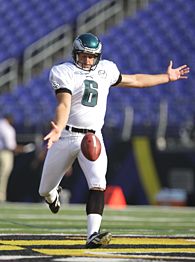
AP Photo
Stop me before I punt again!
-
• Inside your own 20, punt.
• From your 21 to 35, go for it on fourth-and-2 or less.
• From your 36 to midfield, go for it on fourth-and-3 or less.
• From the opposition 49 to opposition 30, go for it on fourth-and-4 or less.
• From the opposition 29 to opposition 3, go for it on fourth-and-3 or less.
• From the opposition 2 or 1, go for it.
• Exception: inside the opponent's 25, attempt a field goal if it's the fourth quarter and a field goal causes a tie or gives you the lead.
A few notes on my sure-fire formula: By only disdaining the punt in situations in which the odds of success are pretty good, my anti-punt strategy takes into account player and crowd psychology. Because fourth-and-short attempts will usually succeed, players will remain upbeat, while the defense will understand that though it occasionally will be sent out with bad field position after a blown try, overall, the team will benefit from rarely punting. Romer's more aggressive strategy creates too much chance of a lustily booing home crowd, or players who think their coach is a fool after, say, a missed fourth-and-3 attempt from your own 10-yard line: and psychology is a big factor in football.
My strategy also values field goals more highly than does Romer's: field goals are nothing to sneeze at, so it makes sense to attempt them on fourth-and-long. Finally, my rules violate my own immutable law of field-goal decisions, namely, Kick Early, Go For It Late. I couldn't think of a way to incorporate Kick Early, Go For It Late into the decision-making tree without causing Accuscore's job to become excessively complex. At any rate, the simulations showed that unless you're in the fourth-quarter exception, statistically you're better off going for the touchdown on fourth-and-goal from the 2 or the 1 -- disproving the Kick Early, Go For It Late law, which can no longer be viewed as immutable. (I've sent the football gods a memo on this.)
In other news, consider this quotation from Tuesday Morning Quarterback: ''It's coming – I can feel it – the Revenge of the Cupcakes is in the air. College football's second echelon is tired of being hired to be clobbered. Sometime this season, a cupcake team is going to stage a major upset of a top 25 school. Thus sayeth the football gods." I wrote that last September, and needless to say I've been dancin' in the streets since Appalachian State, hired by megabucks Michigan to come to college football's largest stadium and play the role of the pushover, hired by Michigan so that the Wolverines could win by 50 points and dance on the sidelines pointing at themselves, staged one of the best and most exciting wins in sports history. This game was so exciting it was thrilling just to listen to on the radio! Just the fourth-quarter play chart is thrilling to read!
Scoring to make it Appalachian State 31, Michigan 26 at the end of the third quarter, Wolverines coaches went for two – ignoring a TMQ immutable kicking law that has not been overturned by computer simulations, Take One Till the Fourth. Many's the team that goes for the deuce too early, then at the end really, really wishes it had taken one. Michigan missed the deuce and then, scoring to take a 32-31 lead late in the fourth quarter, went for two again and missed again. Had the Wolverines gone for the singleton in the third quarter, they would also have gone for the singleton at the end and then Appalachian's last-minute field goal would have tied the game, not won it. Like so many teams that have gone for two too early, at the end Michigan really, really wished it had gone for one.
Now the victors: At this point Appalachian State of beautifully rustic Boone, N.C., is not only good, it's the hottest team in college football at any level. Stretching back to last season, Appalachian State has won three consecutive do-or-die playoff games, then won a championship game, then defeated the nation's No. 5 team on its own turf. Short-term, no football factory school has done anything so impressive. BCS defending champion Florida beat Ohio State, but then wimped out by next scheduling Western Kentucky, a cupcake. Preseason No. 1 USC's short-term performance isn't even close to the Appalachian State run: in their three most recent outings the Trojans lost to UCLA, then won a bowl game, then faced a second-echelon team in Idaho. Appalachian State has won five consecutive max-pressure contests – the Mountaineers are the hottest team south of the NFL. And should New Orleans upset the Colts in the NFL opener, Appalachian State would become the hottest team in football, anywhere, period.
In other blissful news, the regular season is finally, blissfully upon as, and at this point every year I check to make sure the coffee table in front of my HDTV is ready with football annuals. I commend to readers the latest iterations of several volumes. First, the "Official NFL 2007 Record and Fact Book," the league's annual publication that will settle any argument. Second, the "ESPN Pro Football Encyclopedia," Second Edition, which has by far the best historical data of any football annual, and is essential for anyone interested in the long-term history of the NFL. Third, "The Football Scientist" by K.C. Joyner, the ideal volume for sports-stats lovers who want to become so lost in football stats they might never be heard from again. And fourth, "Pro Football Prospectus 2007," compiled by Aaron Schatz and the Football Outsiders conspiracy, a volume that is so good, and so original, there just isn't anything else like it in the sports-book universe.The "Pro Football Prospectus" series exhibits such a deep understanding of the sport that many of its predictions actually come true! Last year's volume predicted, among other things, that LaDainian Tomlinson would led the NFL in touchdowns, while Edgerrin James would fade into the sunset. This year's volume predicts Brady Quinn will be an NFL star, while Larry Johnson fades; that Jacksonville and Washington will have big years, while Chicago and San Diego sputter. I'd heed the wisdom of "Pro Football Prospectus" if I were you.
In fact, I am using the volume for this year's NFL forecast finishes. In the past, seeking something more than simply picking numbers out of the air, I have forecast that every team would finish with exactly the same record as the year before; that parity would cause all 32 teams to finish 8-8; and predicted records that added up to far more defeats than victories (which is how most Sundays seem), even though the final totals of defeats and victories should be symmetrical.
This year, my forecast finishes are the median wins projections generated for "Pro Football Prospectus 2007" by the Football Outsiders software. Because many of these projections include decimal places -- for example, the Minnesota Vikings are forecast to win 7.5 games -- there are decimals in my forecasts. I forecast the Vikings to go 7.5-8.5. And if you add all the records you will find, rather than totaling 256 on each side as they should, they predict an outcome of 255.5-256.5 in the NFL this season. Who will be stuck with the mysterious extra L?
Now -- still America's only all-haiku NFL season predictions!
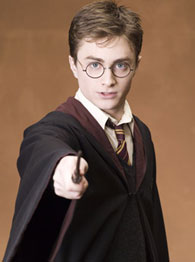
Warner Bros.
On an exclusive basis, Page 2 has obtained this photo of Bill Belichick in his frosh year at Wesleyan.
Expelliarmus!
Is magic wand Bill's secret?
The New England Pats.
Forecast finish: 12.1-3.9
Now holds team dinners
at Nuovo Vesuvio's.
The Jersey/B Jets.
Forecast finish: 8.8-7.2
It's been a long, long,
long time since last playoff win.
The Buffalo Bills.
Forecast finish: 6.2-9.8
Brady Quinn -- who's that?
Big plan: Snazzy punt returns.
Miami Dolphins.
Forecast finish: 5.6-10.4

AP Photo
It's quite close in cosmic terms -- and we can barely see it.
Recently, astronomers using the Very Large Telescope array in Paranal, Chile, the world's most advanced telescope, took these photographs of the rings of Uranus turning edge-on to Earth, an alignment that occurs once every 42 years. The pictures have haunting beauty. I was also struck that, although the VLT is a large, powerful device and Uranus is inside the solar system, in the photos the planet still seems distant and hard to make out. That it's hard to see something inside the solar system gives you an idea of galactic distance -- considering the solar system is about 0.000000002 percent of the Milky Way.
AFC North
Just matter of time
till fans boo Roethlisberger.
The Pittsburgh Steelers.
Forecast finish: 9.1-6.9
Billick: How come he's
still "an offensive genius?"
Bal-a-mer Ravens.
Forecast finish: 9-7
Unorthodox new
stance: hands cuffed behind the back.
The Cinncy Bengals
Forecast finish: 8.7-7.3
If don't win this year,
UPS will change color.
Second Cleveland Browns.
Forecast finish: 7.6-8.4

Wire Image
She thinks shoes are sexier than people.
Each year at the end of August, TMQ eagerly buys the annual "What's Sexy Now?" issue of celeb-froth magazine InStyle -- both for the amusement value of the mindlessness of the content, and for the pleasing reassurance that the arrival of another "What's Sexy Now?" issue means the offseason has finally ended and football is about to resume.
This year's "What's Sexy Now?" issue features a photo essay on "Hollywood's 15 Hot-to-the-Touch Stars!" There follows pictures of 29 people -- apparently InStyle had to appease agents for 29 of the 15 sexiest Hollywood celebs to insure their cooperation with future schmaltz. Much of InStyle appears to be written by stars' publicists, thus sparing Time Warner the cost of reporters and editors. Brad Pitt and Angelina Jolie, for example, are described as "unspeakably gorgeous" and "super-talented" and "beyond philanthropic" and even "ultra-family-oriented." (No fact-checking expense either, apparently.)
The most cringe-worthy section of every annual "What's Sexy Now?" is the article in which stars pronounce what they find sensual: or at least, in which stars' publicists try to imagine what the stars might have said. Rachel Bilson, a deep thinker, declares that "a cute pair of shoes" is what's sexy now. Fergie says, "When you only get a glimpse of something, there's that mystery, 'What's underneath?' You want to know more." Wait: by that definition porn stars aren't sexy, but everyone you pass walking down the street is. Samuel L. Jackson says the beach at Capetown, South Africa, is sexy. Sarah Michelle Geller says she likes to go "to a museum at night -- which is really sexy, when no one's there." Sarah, if you're in the museum, then there is someone there! Taylor Kitsch, a 26-year-old who plays the 17-year-old Tim Riggins on "Friday Night Lights," says that live music in "a dark, low-key Austin bar" is sexy. Hey, Taylor: Riggins is too young to drink in clubs! Ginnifer Goodwin cites Paul Newman, chocolate and "the South" as sexy now. Rosario Dawson says seeing a person look at someone else's mouth is sexy. (This is the sole comment in the entire issue that actually refers to the erotic.) Joy Bryant says, "All food is sexy, but dessert is the sexiest." All food is sexy? Apparently, she has never dined at the ESPN cafeteria.

Wire Image
What's underneath her skull is the big question.
AFC South
Brady Quinn -- who's that?
Big plan: Mess at quarterback.
Jacksonville Jaguars.
Forecast finish: 11.8-4.2
"It's raining, run the
ball!" Heard football gods' edict!
Ring-clad Indy Colts.
Forecast finish: 8.9-7.1
Trojans not surprised:

AP Photo
Rosario Dawson had an actual erotic observation -- how did that get past the InStyle editors?
Passed on Young, Bush, Quinn:
Dullest NFL team ev'r?
The Houston Texans.
Forecast finish: 6-10
A Coaching Odyssey
After scoring just 17 points per game in 2006, Carolina fired offensive coordinator Dan Henning, replacing him with Jeff Davidson. Henning, who's 65, exemplifies the modern coaching vagabond. Entering athletics as a quarterback for William & Mary, then playing briefly for the San Diego Chargers, Henning shifted to coaching in 1968. Since that time he has held 17 different coaching jobs and been fired 11 times.
Here is The Coaching Odyssey of Dan Henning: Assistant at Florida State; left for promotion at Virginia Tech; left for promotion at Houston Oilers, fired; offensive coordinator at Virginia Tech, fired; offensive coordinator at Florida State, fired; offensive coordinator at New York Jets, fired; offensive coordinator at Miami Dolphins, fired; offensive coordinator at Washington Redskins, left for promotion at Atlanta Falcons; head coach of Atlanta Falcons, fired; offensive coordinator at Washington Redskins, left for promotion at San Diego Chargers; head coach of San Diego Chargers, fired; offensive coordinator at Detroit Lions, left for promotion at Boston College; head coach at Boston College, fired; offensive coordinator at Buffalo Bills, fired; offensive coordinator at New York Jets, fired; takes year off (probably needed the entire year to straighten out his W-2s); offensive coordinator at Carolina, fired.

AP Photo
He's available to hire and fire.
AFC West
Broncos' key stat: Five
thousand two-hundred eighty.
The Denver Broncos.
Forecast finish: 8.7-7.3
Come January
the clock always strikes midnight.
San Diego Bolts.
Forecast finish: 8.6-7.4
"Hey Mom, can I coach
Sunday?" Lane needs permission.
The Oakland Raiders.
Forecast finish: 6.5-9.5
First Roaf and now Shields:
Midwest team loses its Wills.
Kansas City Chiefs.
Forecast finish: 5.2-10.8
This is an actual sports item -- what's it doing in TMQ?
Five teams -- Cleveland, Detroit, Minnesota, Oakland and Tampa -- entered the 2006 season with bad situations at quarterback, neither an accomplished veteran who hadn't yet turned gray nor a potential young star. These teams finished a combined 19-61. How can something so basic as the need for a premium player at quarterback go unnoticed by NFL coaches?
Now six teams -- Chicago, Detroit, Jacksonville, Miami, Minnesota and Tampa -- enter the 2007 season with bad situations at quarterback, while two others, Atlanta and Oakland, have unknown situations at quarterback. How can something so basic as the need for a premium player at quarterback go unnoticed by NFL coaches?
NFC East
Coach McNabb mad re:
draft. So, too, G.M. McNabb.
The Philly Eagles.
Forecast finish: 11-5
If Snyder can't run
team, how did he get so rich?
"Washington" Redskins.
Forecast finish: 8.2-7.8
Tiki, Katie -- soon
cute-host pair on QVC?
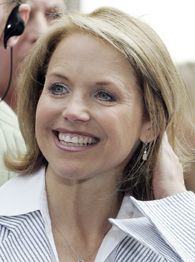
AP Photo
Katie and Tiki could be TV's cutest couple.
Forecast finish: 7-9
It's been a long, long,
long time since last playoff win.
The Dallas Cowboys.
Forecast finish: 6.4-9.6
Offensive linemen: Boycott Canton!
Tuesday Morning Quarterback has long maintained the Pro Football Hall of Fame is admitting too few gentlemen. So, naturally, I was pleased by last week's announcement that Canton will increase its annual maximum class from six to seven, while increasing the minimum class from three to four.
During the 1960s, Hall of Fame classes of seven or eight were the norm. In the last decade, there have been several classes of just four or five, insufficient to clear the backlog of players worthy of admission. TMQ has supposed that a reason the Hall of Fame selectors take so few is that the induction ceremony is held outdoors on an August afternoon, and the committee doesn't want to make any decision that prolongs its time in the blazing sun.
This year, the ceremony was switched to a cooler 6 p.m. start -- and immediately afterward, the selectors pronounced themselves willing to christen more honorees. But don't just make the seven-member class allowable, make it mandatory! Comparisons of Canton to baseball's Cooperstown, which only admits a few per year, aren't valid owing to the larger number of players involved in football and to its status as the quintessential team sport. (Teammates matter more in football than baseball, thus more should be honored.)
A higher rate of Canton admission is also required to repair the inequity between glory boys and linemen. The Hall of Fame currently has 82 quarterbacks and running backs versus 48 offensive linemen -- though there are twice as many offensive linemen on the field as quarterbacks and running backs. Thus my full proposal: make seven Hall of Fame admissions per year mandatory, and allow only offensive linemen to be admitted to Canton from now until 2013, at which point parity with quarterbacks and running backs will have been achieved.
Note: the Hall of Fame insists on calling what it does to great players "enshrinement" rather than the less pretentious "induction." To "enshrine" means "to hold sacred," and usually refers to the bones of saints placed in ossuaries.
NFC North
Brett Favre: shoe-in for
AARP Man of Year.
The Green Bay Packers.
Forecast finish: 9.5-6.5
It's raining and our
QB is bad -- so let's throw!
The Chicago Bears.
Forecast finish: 8.3-7.7
Loudest dome, red-hot
cheer-babes: Um, about the teamů
Minnesota Vikes.
Forecast finish: 7.5-8.5
Matt Millen in charge?
Makes Cheney look competent.
The Detroit Lions.
Forecast finish: 7.1-8.9
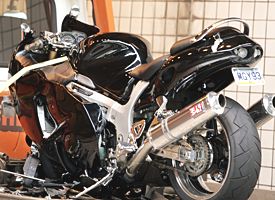
AP Photo
Roethlisberger's bike after the crash -- he would have been 28 times safer in a car.
Three prominent NFL players -- Kellen Winslow, Ben Roethlisberger and LaVar Arrington -- have been severely injured in recent motorcycles crashes. Is there some kind of peculiar motorcycle misuse happening in professional sports? No. What's going on is that NFL players are mirroring the social trend as a whole: which is that cars and trucks are causing steadily less harm, while motorcycles grow steadily more dangerous.
Check Table 3 of this report from the National Highway Traffic Safety Administration, giving statistics for 2005, the most recent year for which stats are available. Fatal highway accidents are measured per 100 million vehicle miles traveled -- this takes into account ever-increasing driving distances and vehicle use. Measured per million miles traveled, the fatality rate for passenger cars has been declining for three decades on an almost annual basis, from 3.68 in 1975 to 1.55 in 2005, the 2005 number being the lowest fatality rate ever. The light truck (pickups and SUVs) fatality rate has declined steadily, from 4.23 in 1975 to 2.01 in 2005. In a trip using a car, SUV or pickup truck, your odds of dying today are less than half what they were in 1975. Now look at the motorcycle numbers. After declining till the early 1990s, the motorcycle fatality rate has begun to skyrocket -- from 21.43 in 1997 to 43.22 in 2005. Today a motorcycle rider is twice as likely to die in an accident as a decade ago.
What has happened? Over recent decades cars, SUVs and pickups have added airbags, ABS and impact-management engineering, making them safer; while the craze for colorful but overpowered sportsbikes has arrived, making motorcycles more dangerous. Today's sportsbikes not only have a higher horsepower-to-weight ratio than cars, they have more horsepower per weight than airplanes! The sportsbike Roethlisberger nearly died on last year weighed 478 pounds and possessed a 160-horsepower engine -- five times the horsepower-to-weight ratio of a Cessna 172. The ZX-14 sportsbike Arrington nearly died on this year weighed 474 pounds and possessed an even more powerful 187-horsepower engine -- six times the horsepower-to-weight ratio of the Cessna.
Kawasaki lists every technical detail of the ZX-14 except the horsepower -- which is the number sportsbike lovers are most interested in, but which if published would make the company seem socially irresponsible. And while horsepower keeps rising in sportsbikes, bike racing and X-Game-style events have popularized one-wheel riding and other risky maneuvers that increase road deaths. If the fatality rate of cars had doubled in just 10 years, this would be a national outrage. How come no one seems to care or even notice that motorcycle fatality rates have doubled in a decade? Some 4,655 Americans died in motorcycle crashes in 2005, yet the mainstream media say little, and Congress has taken no action to impose horsepower limits or safety standards on sportsbikes.
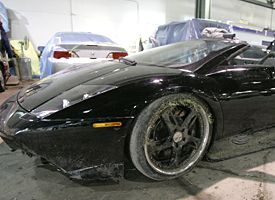
AP Photo
Briggs's Murcielago -- 632 horsepower is preposterous.
Perhaps a person who has passed a rigorous motorcycle safety course taught by a certified instructor should be allowed to operate a powerful sportsbike on public roads. But a standard motorcycle operator's license -- and LaVar Arrington did not even have one of those -- is hardly sufficient for operating a device with six times the power-to-weight ratio of an airplane.
Just think about the big number, the fatality rate. Right now for motorcycles the fatality rate is 43.22, compared to 1.55 for cars -- which means you are 28 times more likely to die riding a sportsbike than sitting inside a car. If nothing else, NFL and other professional sports contracts should ban professional athletes from riding sportsbikes: Both to protect the clubs' investments in players, and to prevent athletes from making sportsbikes seem cool when the reality is they are deadly.
While we're at it, pro sports contracts should also forbid athletes from driving overpowered exotic sports cars. The Lamborghini Murcielago that Bears linebacker Lance Briggs allegedly spun out on the Edens Expressway in Chicago last week has a preposterous 632-horsepower engine, and we've seen the evidence that Briggs was unable to control that much power. But he survived because he was in a car, not on a bike: the car had safety systems, including automated rollover bars that extended around Briggs when the car's computer detected impending loss of control. Owing to their much lower weights, the sportsbikes Winslow, Roethlisberger and Arrington wiped out on possessed roughly double the power-to-weight ratios of the Lamborghini -- yet offered their riders little protection.
NFC South
Jon Gruden aging
faster than Geena Davis.
Tampa Buccaneers.
Forecast finish: 9-7
Didn't you used to
be the Car'lina Panthers?
Carolina Cats.
Forecast finish: 8.9-7.1
Bark worse than their bite.
Now every game's a woofer.
Atlanta Falcons.
Forecast finish: 7.6-8.4
"Seeking return to
title game." Can that be right?
The New Orleans Saints.
Forecast finish: 7.4-8.6
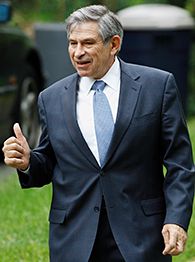
AP Photo
Falsely accused -- but deserved what he got.
Here, in Arabic, is the World Bank's statement about the recent resignation of its leader, Paul Wolfowitz. Click on the upper left for English, and you'll find the institution's board of directors declared Wolfowitz "assured us that he acted ethically and in good faith in what he believed were the best interests of the institution, and we accept that." The directors continued, "We also accept that others involved acted ethically and in good faith."
Wait a moment -- if everyone involved acted ethically and in good faith, then what was the problem? The hounding out of Wolfowitz seemed an example of what the social critic Mickey Kaus memorably called "framing the guilty." The specific charge against Wolfowitz, that he approved a raise for his girlfriend, is the sort of thing that should result in a letter of reprimand, not a public meltdown of the world's leading multilateral financial institution. For the media and the bank's board to agonize as if a shocking scandal had occurred was an exercise in framing Wolfowitz: to say nothing of the unfair treatment of Shaha Riza, who was publicly embarrassed though she not only did nothing improper, she wasn't even accused of doing anything improper!
The substantive point against Wolfowitz is he helped push the United States into the invasion of Iraq, which increasingly seems both immoral -- how many thousands of innocent Iraqi civilians have we killed at this point? -- and the worst foreign policy mistake in our nation's history. If Wolfowitz's judgment about Iraq was wantonly wrong, then he could not be trusted with any other important matter involving international policy. But Wolfowitz's critics refused simply to come out and say, "An idiot should not be running the World Bank." Instead, they framed him with an underhanded charge.
As a character remarks in George Bernard Shaw's "Saint Joan," the first Church trial of Joan of Arc was scrupulously honest, conducted precisely in accordance with rules of the era, and led to a corrupt result, Joan's execution; her posthumous second trial was completely rigged and led to the right result, the exoneration of her name. The 2007 media trial of Wolfowitz was unfair and rigged, and led to the right result.
NFC West
Generic football:
Can you name the guys who start?
The Forty-Niners.
Forecast finish: 8.1-7.9
This year no Madden
cover boys. A good omen!
Seattle Seahawks.
Forecast finish: 8-8
Oh, no! We're up by
20 points! We are doomed, doomed!
Arizona Cards.
Forecast finish: 6-10
Off radar -- though more
wins in decade than Packers.
The St. Louis Rams.
Forecast finish: 5.8-10.2
Obscure College Score of the Week: Avila 38, Culver-Stockton 21. Located in Kansas City, Mo., Avila University sponsors a mock trial team that competes nationally. How long until there are cheerleaders for mock trials? Here is a mock trial cheer:
Our hands are high, our feet are low
And to the slammer this defendant should go.
Running Up the Score Watch: Taking a 70-10 lead over Division I-AA cupcake opponent Murray State at the middle of the third quarter, heavily favored Louisville did not attempt another pass. Leading Averett 75-7 with two minutes remaining, facing third-and-goal, heavily favored Mount Union knelt twice to avoid scoring again. These instances of sportsmanship merit noting because good-sport behavior has become so rare in college football. Consider the Boise-Weber collision. Leading Division I-AA cupcake Weber State 49-0 at intermission, heavily favored Boise State attempted 16 passes in the second half, including a pass with just 1:15 remaining in the game while ahead 56-7. What terrible sportsmanship! All the good vibes Boise State earned with its BCS bowl upset of Oklahoma will disappear fast if coach Chris Petersen becomes known for trying to humiliate lesser teams by running up the score.
Next Week: During the preseason, Tuesday Morning Quarterback uses "vanilla" items designed to confuse scouts from other sports columns. Starting next week, it's the real thing -- I'll come at readers from all directions with unorthodox grammatical structures and aggressive, attacking topic sentences. In addition to writing Tuesday Morning Quarterback, Gregg Easterbrook is the author of "The Progress Paradox: How Life Gets Better While People Feel Worse" and other books. He is also a contributing editor for The New Republic, The Atlantic Monthly and The Washington Monthly and is a visiting fellow at the Brookings Institution.
Comments
You must be signed in to post a comment